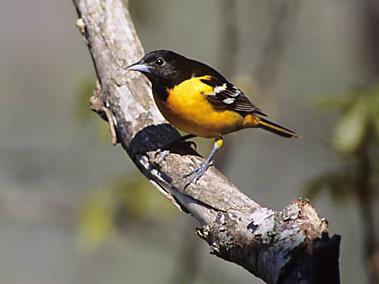Oriole - Northern
Baltimore Oriole, Bullock's Oriole Scientific Name: Icterus galbula
Mon, 30th June, 2025 - 10:04 pm GMT
Sponsor Ads:

Alternative Name
Baltimore Oriole, Bullock's Oriole Scientific Name: Icterus galbulaBasic Info
Male and female Northern Orioles look quite different from each other. The female is a yellowish-green, with her belly and lower wings being yellowish-orange. The male has a black tail, wings, head and back, and with an orange rump, shoulder and breast. Mature individuals usually measure between18 and 20 centimeters in length and have a wingspan between 29 and 31 centimeters.
Health
Northern Orioles love all kinds of food, so attracting them to your backyard should be easy. They really love grape jelly, so leaving a bit out for them in the summer months should be a sure-fire way to get these birds in your backyard. They will also drink from hummingbird feeders if the tube used to feed from is long enough for them to use. They also enjoy peanuts, orange halves, and mulberries. Keeping these foods around, as well as a fresh, clean, well-kept birdbath, will keep the Northern Oriole coming back. Breeding During the mating season, the female Northern Oriole will lay a clutch of four eggs. The incubation period will last around 12 to 14 days, and when hatched, will be cared for by both the male and the female. After another two weeks, the birds are ready to fly from the nest - the mating pair will only raise one brood per year.Habitat
N/ABehavior
The Northern Oriole, also known as the "Baltimore Oriole" or "Bullocks Oriole", is a common sign of spring and summer in many parts of the United States and Canada. They have a varied diet, feeding on blossoms and small berries in the springtime, and in the summertime and in the rest of the year commonly feasting on snails, spiders and insects. They prefer building nests during these summer months in residential areas, preferably a place with a lot of trees in it, and the occasional orchard. The Oriole has a knack for nest building. They can build their nests nearly anywhere they choose, although they usually put them in between two sturdy twigs at the end of a branch. They will build their nests out of hair, string, yarn, small bits of plant and twigs and weave them into a sturdy bowl to keep their young safe and sound. The Oriole also loves water - if you put a few misters out or spray down the tree it lives in, it will enjoy the cool water.Origin
North AmericaHistory
The Northern Oriole is a beautiful bird that has delighted bird watchers in North and South America for years. The Northern Oriole spends its spring and summers in many parts of the United States and Canada, while it winters in Mexico and South America.Common Foods
They are also known to eat many different foods from feeders including nectar, fruits and jellies.Sponsor Ads:
Pessimists are the world's happiest people.... Ninety percent of the time they are right, and the other ten percent they are pleasantly surprised. -- Unknown
Oriole - Northern
Coded by: BGID® | ALL RIGHTS RESERVED Copyright © 2000-2025
Disclaimer | Privacy | Report Errors / Contact | Credits








 Preparing For China. China is growing their military. China Military Technology - can it keep up with the US?
Preparing For China. China is growing their military. China Military Technology - can it keep up with the US?  versus
versus 

 versus
versus 
 This Thread is about the North Korean Military itself - the kind of army, navy, and air force they have.
This Thread is about the North Korean Military itself - the kind of army, navy, and air force they have. 
 versus
versus 
 versus
versus  versus
versus